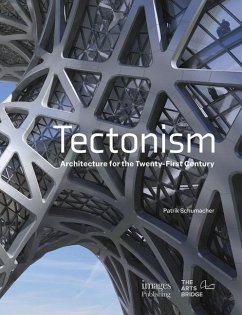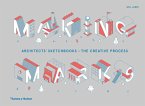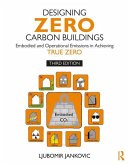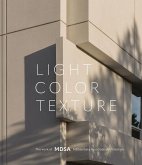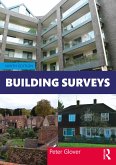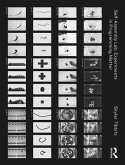Schade – dieser Artikel ist leider ausverkauft. Sobald wir wissen, ob und wann der Artikel wieder verfügbar ist, informieren wir Sie an dieser Stelle.
- Gebundenes Buch
- Merkliste
- Auf die Merkliste
- Bewerten Bewerten
- Teilen
- Produkt teilen
- Produkterinnerung
- Produkterinnerung
In this lavishly illustrated text, Patrik Schumacher, a world-leading architectural theorist and principal architect with Zaha Hadid Architects, provides a comprehensive analysis on tectonism as evolving into the new architecture for the 21st century.
Andere Kunden interessierten sich auch für
![Making Marks Making Marks]() Will JonesMaking Marks37,99 €
Will JonesMaking Marks37,99 €![Designing Zero Carbon Buildings Designing Zero Carbon Buildings]() Ljubomir Jankovic (UK Birmingham City University)Designing Zero Carbon Buildings70,99 €
Ljubomir Jankovic (UK Birmingham City University)Designing Zero Carbon Buildings70,99 €![Light, Color, Texture Light, Color, Texture]() Michael D. SzerbatyLight, Color, Texture37,99 €
Michael D. SzerbatyLight, Color, Texture37,99 €![Building Surveys Building Surveys]() Peter GloverBuilding Surveys68,99 €
Peter GloverBuilding Surveys68,99 €![Architect's Pocket Book Architect's Pocket Book]() Jonathan Hetreed (UK Hetreed Ross Architects)Architect's Pocket Book45,99 €
Jonathan Hetreed (UK Hetreed Ross Architects)Architect's Pocket Book45,99 €![Self-Assembly Lab Self-Assembly Lab]() Skylar Tibbits (USA MIT)Self-Assembly Lab66,99 €
Skylar Tibbits (USA MIT)Self-Assembly Lab66,99 €![Creating Urban Agricultural Systems Creating Urban Agricultural Systems]() Gundula Proksch (USA University of Washington)Creating Urban Agricultural Systems86,99 €
Gundula Proksch (USA University of Washington)Creating Urban Agricultural Systems86,99 €-
-
-
In this lavishly illustrated text, Patrik Schumacher, a world-leading architectural theorist and principal architect with Zaha Hadid Architects, provides a comprehensive analysis on tectonism as evolving into the new architecture for the 21st century.
Produktdetails
- Produktdetails
- Verlag: Images Publishing Group Pty Ltd
- Seitenzahl: 176
- Erscheinungstermin: 17. Oktober 2023
- Englisch
- Abmessung: 235mm x 183mm x 23mm
- Gewicht: 726g
- ISBN-13: 9781864708967
- ISBN-10: 1864708964
- Artikelnr.: 61935689
- Herstellerkennzeichnung
- Libri GmbH
- Europaallee 1
- 36244 Bad Hersfeld
- gpsr@libri.de
- Verlag: Images Publishing Group Pty Ltd
- Seitenzahl: 176
- Erscheinungstermin: 17. Oktober 2023
- Englisch
- Abmessung: 235mm x 183mm x 23mm
- Gewicht: 726g
- ISBN-13: 9781864708967
- ISBN-10: 1864708964
- Artikelnr.: 61935689
- Herstellerkennzeichnung
- Libri GmbH
- Europaallee 1
- 36244 Bad Hersfeld
- gpsr@libri.de
Patrik Schumacher is principal of Zaha Hadid Architects and is leading the firm since Zaha Hadid’s passing in March 2016. He joined Zaha Hadid in 1988 and was seminal in developing Zaha Hadid Architects to become a 500 strong global architecture and design brand. Patrik Schumacher is a winner of the Royal Institute of British Architects’ Stirling Prize for excellence in architecture and an academician of the Berlin Academy of Arts. In 1996 he founded the Design Research Laboratory at the Architectural Association in London where he continues to teach. Patrik Schumacher holds a PhD in Cultural Science and in 2010–2012 he published his two-volume theoretical treatise "The Autopoiesis of Architecture." Patrik Schumacher is widely recognized as a thought leader within the fields of architecture, urbanism and design, and has contributed over 100 articles to architectural journals and anthologies.
Preface 6 Introduction 8 Architecture’s Task: The Designed Environment
as Societal Ordering System 12 1. First Premise: Parametricism 15 1.1
The Indispensible Concept of Style 16 1.2 Parametricism Against Pluralism
20 1.3 Parametricism and Progress 23 1.4 Conceptual and Operational
Definition of Parametricism 25 1.5 Style War: Parametricism Versus
Minimalism 31 2. Second Premise: Computational Engineering 35 2.1
Collaboration and Distinction Between Architecture and Engineering 36 2.2
Structural Fluidity: From Typology to Topology in Structural Engineering
39 3. From Engineering Inspiration to Architectural Style: Tectonism 48
3.1 Making Engineering Logics Speak 51 3.2 Accentuation and Suppression
55 3.3 Tectonic Articulation 60 4. Tectonism as Style: Expressive
Utilization of Engineering Logics 66 4.1 Historical Precedents 69 4.2
Structural System Optimizations as Drivers of Tectonic Articulation 73
Candela Revisited 85 Beijing Daxing International Airport 90 One
Thousand Museum 94 Morpheus Hotel & Resort at City of Dreams 98
Inkstone House, Cultural Centre 102 4.3 Environmental Engineering Logics
as Drivers of Tectonic Articulation 103 King Abdullah Petroleum Studies &
Research Centre (KAPSARC) 104 Central Bank of Iraq 110 4.4 Fabrication
Methods as Drivers of Tectonic Articulation 114 Arum 115 Vaulted Willow
117 Zephyr 119 Science Museum Benches 119 Thallus 121 ACADIA 3D
Printed Chair 122 Nagami Chairs: Rise, Bow 123 Striatus Bridge 124
Parametric Dinner Jacket 129 4.5 From Semiological Form-to-Function
Correlations to a Systematic Visual-Spatial Language 130 4.6 The
Progression of Styles in Terms of Order and Freedom 149 References 156
Image Credits 161 Project Credits 162 Index 172
as Societal Ordering System 12 1. First Premise: Parametricism 15 1.1
The Indispensible Concept of Style 16 1.2 Parametricism Against Pluralism
20 1.3 Parametricism and Progress 23 1.4 Conceptual and Operational
Definition of Parametricism 25 1.5 Style War: Parametricism Versus
Minimalism 31 2. Second Premise: Computational Engineering 35 2.1
Collaboration and Distinction Between Architecture and Engineering 36 2.2
Structural Fluidity: From Typology to Topology in Structural Engineering
39 3. From Engineering Inspiration to Architectural Style: Tectonism 48
3.1 Making Engineering Logics Speak 51 3.2 Accentuation and Suppression
55 3.3 Tectonic Articulation 60 4. Tectonism as Style: Expressive
Utilization of Engineering Logics 66 4.1 Historical Precedents 69 4.2
Structural System Optimizations as Drivers of Tectonic Articulation 73
Candela Revisited 85 Beijing Daxing International Airport 90 One
Thousand Museum 94 Morpheus Hotel & Resort at City of Dreams 98
Inkstone House, Cultural Centre 102 4.3 Environmental Engineering Logics
as Drivers of Tectonic Articulation 103 King Abdullah Petroleum Studies &
Research Centre (KAPSARC) 104 Central Bank of Iraq 110 4.4 Fabrication
Methods as Drivers of Tectonic Articulation 114 Arum 115 Vaulted Willow
117 Zephyr 119 Science Museum Benches 119 Thallus 121 ACADIA 3D
Printed Chair 122 Nagami Chairs: Rise, Bow 123 Striatus Bridge 124
Parametric Dinner Jacket 129 4.5 From Semiological Form-to-Function
Correlations to a Systematic Visual-Spatial Language 130 4.6 The
Progression of Styles in Terms of Order and Freedom 149 References 156
Image Credits 161 Project Credits 162 Index 172
Preface 6 Introduction 8 Architecture’s Task: The Designed Environment
as Societal Ordering System 12 1. First Premise: Parametricism 15 1.1
The Indispensible Concept of Style 16 1.2 Parametricism Against Pluralism
20 1.3 Parametricism and Progress 23 1.4 Conceptual and Operational
Definition of Parametricism 25 1.5 Style War: Parametricism Versus
Minimalism 31 2. Second Premise: Computational Engineering 35 2.1
Collaboration and Distinction Between Architecture and Engineering 36 2.2
Structural Fluidity: From Typology to Topology in Structural Engineering
39 3. From Engineering Inspiration to Architectural Style: Tectonism 48
3.1 Making Engineering Logics Speak 51 3.2 Accentuation and Suppression
55 3.3 Tectonic Articulation 60 4. Tectonism as Style: Expressive
Utilization of Engineering Logics 66 4.1 Historical Precedents 69 4.2
Structural System Optimizations as Drivers of Tectonic Articulation 73
Candela Revisited 85 Beijing Daxing International Airport 90 One
Thousand Museum 94 Morpheus Hotel & Resort at City of Dreams 98
Inkstone House, Cultural Centre 102 4.3 Environmental Engineering Logics
as Drivers of Tectonic Articulation 103 King Abdullah Petroleum Studies &
Research Centre (KAPSARC) 104 Central Bank of Iraq 110 4.4 Fabrication
Methods as Drivers of Tectonic Articulation 114 Arum 115 Vaulted Willow
117 Zephyr 119 Science Museum Benches 119 Thallus 121 ACADIA 3D
Printed Chair 122 Nagami Chairs: Rise, Bow 123 Striatus Bridge 124
Parametric Dinner Jacket 129 4.5 From Semiological Form-to-Function
Correlations to a Systematic Visual-Spatial Language 130 4.6 The
Progression of Styles in Terms of Order and Freedom 149 References 156
Image Credits 161 Project Credits 162 Index 172
as Societal Ordering System 12 1. First Premise: Parametricism 15 1.1
The Indispensible Concept of Style 16 1.2 Parametricism Against Pluralism
20 1.3 Parametricism and Progress 23 1.4 Conceptual and Operational
Definition of Parametricism 25 1.5 Style War: Parametricism Versus
Minimalism 31 2. Second Premise: Computational Engineering 35 2.1
Collaboration and Distinction Between Architecture and Engineering 36 2.2
Structural Fluidity: From Typology to Topology in Structural Engineering
39 3. From Engineering Inspiration to Architectural Style: Tectonism 48
3.1 Making Engineering Logics Speak 51 3.2 Accentuation and Suppression
55 3.3 Tectonic Articulation 60 4. Tectonism as Style: Expressive
Utilization of Engineering Logics 66 4.1 Historical Precedents 69 4.2
Structural System Optimizations as Drivers of Tectonic Articulation 73
Candela Revisited 85 Beijing Daxing International Airport 90 One
Thousand Museum 94 Morpheus Hotel & Resort at City of Dreams 98
Inkstone House, Cultural Centre 102 4.3 Environmental Engineering Logics
as Drivers of Tectonic Articulation 103 King Abdullah Petroleum Studies &
Research Centre (KAPSARC) 104 Central Bank of Iraq 110 4.4 Fabrication
Methods as Drivers of Tectonic Articulation 114 Arum 115 Vaulted Willow
117 Zephyr 119 Science Museum Benches 119 Thallus 121 ACADIA 3D
Printed Chair 122 Nagami Chairs: Rise, Bow 123 Striatus Bridge 124
Parametric Dinner Jacket 129 4.5 From Semiological Form-to-Function
Correlations to a Systematic Visual-Spatial Language 130 4.6 The
Progression of Styles in Terms of Order and Freedom 149 References 156
Image Credits 161 Project Credits 162 Index 172

